
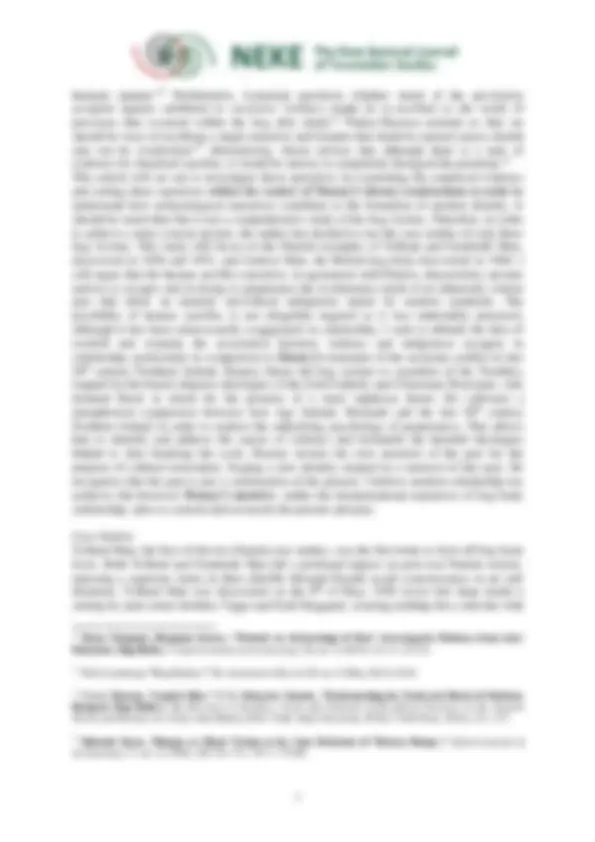
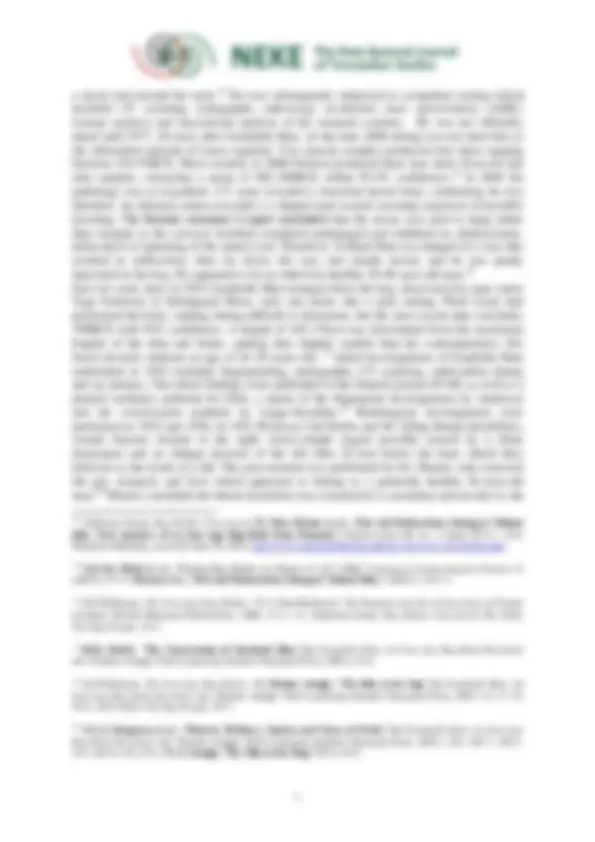
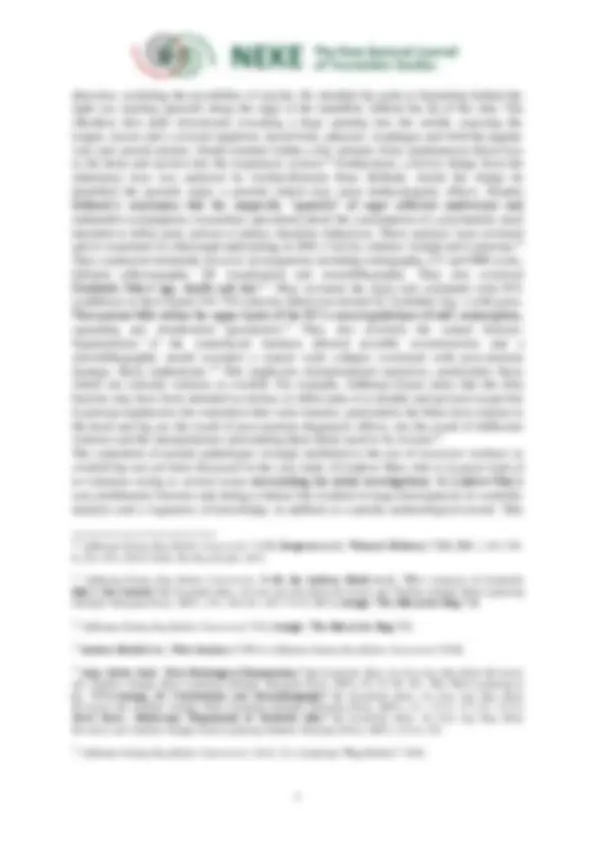
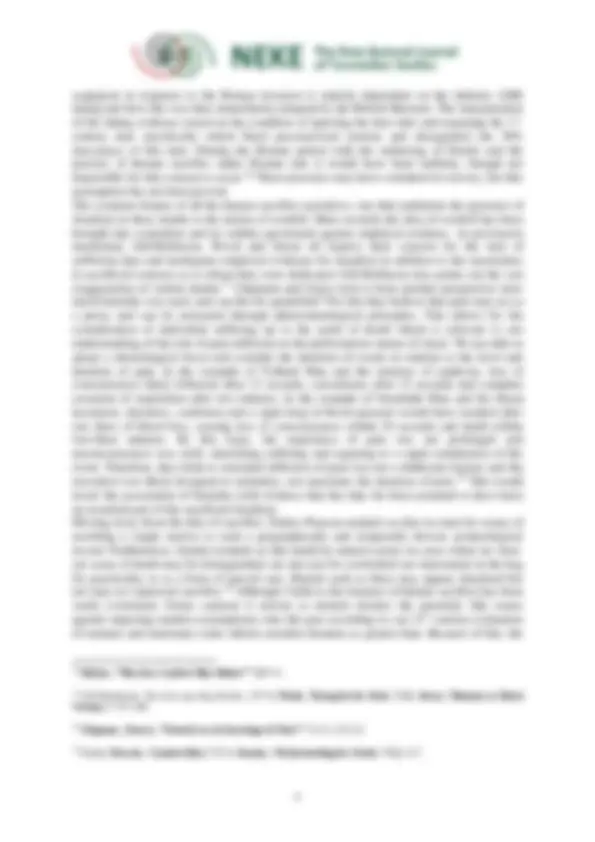
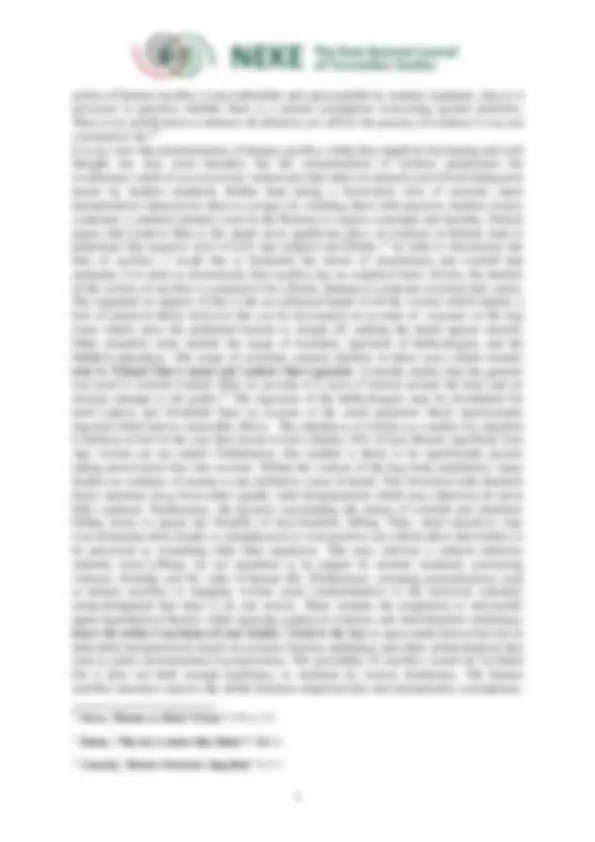



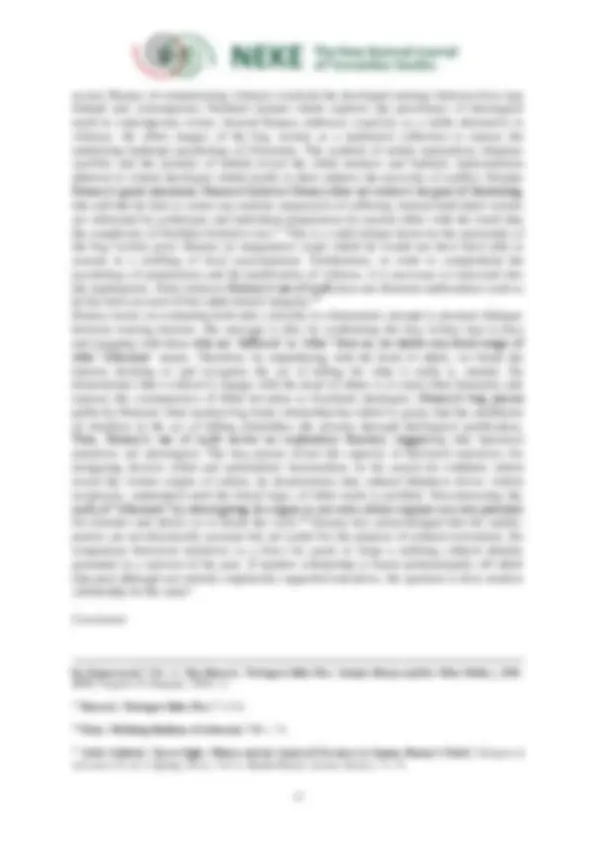
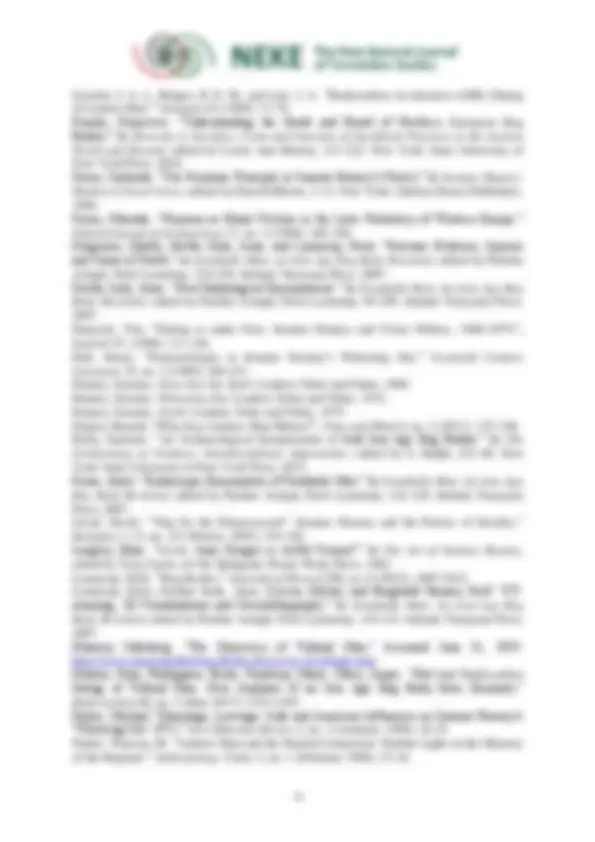



Study with the several resources on Docsity

Earn points by helping other students or get them with a premium plan


Prepare for your exams
Study with the several resources on Docsity

Earn points to download
Earn points by helping other students or get them with a premium plan
Community
Ask the community for help and clear up your study doubts
Discover the best universities in your country according to Docsity users
Free resources
Download our free guides on studying techniques, anxiety management strategies, and thesis advice from Docsity tutors
The use of bog bodies as metaphors of adversity in Seamus Heaney's poetry and the theoretical interpretations of historians and archaeologists. The article investigates the narratives surrounding the bog bodies, their injuries, and the potential for human sacrifice. It also discusses Heaney's treatment of contemporary violence and his resolution to the destructive cycle through poetry.
Typology: Study notes
1 / 19

This page cannot be seen from the preview
Don't miss anything!












Introduction During the late 20th^ century the Northern Irish poet Seamus Heaney sought to use the bog bodies as metaphorical emblems of adversity to express a profound sense of tragedy and to comprehend the underlying drivers of the sectarian violence of his own time in a series of poems known as the ‘bog poems.’^1 Thus far, no literary inquiry has been undertaken to investigate the archaeological interpretations of the bog bodies. This study aims to do just that in order to optimistically uncover by delving into a literary analysis of the mind of Heaney, the inherent bias entrenched in modern archaeological interpretations of the bog bodies. Bog bodies, also known as the bog victims or bog people, are classified as the phenomenon of human cadavers naturally mummified in peat bogs. They are meticulously preserved including their soft tissues such as skin, hair and nails on account of the anaerobic properties of the sphagnum moss. They typically exhibit signs of extreme violence, commonly termed “overkill,” meaning the use of unnecessarily excessive force to kill. The interment of bodies in bogs is spatially and temporally extensive, spanning throughout northwest Europe (Denmark, Germany, The Netherlands) as well as the UK and Ireland, dating from approximately 2000BCE-400CE. It is unknown how many bog people have existed throughout time as many were likely reburied in Christian cemeteries, improperly conserved, forgotten in storage or ground into mummy powder and consumed as medicine. The continuation of repeated location as well as expansive geographic distribution is suggestive of votive deposition. The votive nature of their burial is further conveyed by the many other votive deposits in bogs which include plows, dress fittings, clothing, wagons, cauldrons, weaponry such as leather shields and swords, gold torques, wooden statuettes, pots, scabbards, chapes, spearheads, wooden knives, bridle parts, yokes, drinking vessels and butter. Some scholars argue that the presence of other votive depositions in bogs by association infers ritualization onto the deposition of bodies in bogs.^2 The first usage of the term “bog bodies” was by Professor of Archaeology and History Johanna Mestorf in 1871. Mestorf was the first to relate the bog bodies to Tacitus’ social ritual theory. This interpretation is based on the Germania , chapter 12, which depicts the deposition of people in bogs as a form of social cleansing against outcasts, or as Tacitus refers to them, “ corpores infames” (sodomists). Then in 1922 German Historian Karl Von Amira extended this interpretation to include the act of human sacrifice for divine rectification which he believed was evident by the use of restraints, excessive violence and the denial of burial.^3 However, the foundation of theoretical interpretation can only truly be attributed to the Danish Archaeologist P.V. Glob’s publication in 1965 The Bog People , the first comprehensive study (^1) Heaney often borrowed the phrase “emblems of adversity” from Yeats’ second section of “Meditations in a Time of Civil War” to describe his use of the bog bodies (see also note 43). (^2) Parker-Pearson, “Lindow Man and the Danish Connection: Further Light on the Mystery of the Bogman,” Anthropology Today 2, no.1 (Feb 1986):16; Henry Chapman,” The Landscape Archaeology of Bog Bodies,” Journal of Wetland Archaeology 15 (2015): 117; Eamonn Kelly, “An Archaeological Interpretation of Irish Iron Age Bog Bodies.” in The Archaeology of Violence: Interdisciplinary Approaches, ed. S. Ralph (New York, State University of New York Press, 2012), 237-8. (^3) Morten Ravn, “Bog Bodies-A Burial Practice during the Early Iron Age?” in The Iron Age on Zealand; Status and Perspectives, ed. Linda Boye (Copenhagen: The Royal Society of Northern Antiquaries, 2011), 108-110.
of Iron Age bog bodies of north-western Europe. Within a few years it established the most recognizable tropes and served as the founding text of a narrative scholarship characterized by forensic, folk history and popular discourses of poetically pathic proportions. Glob quickly accepted the human sacrifice narrative and connected this whimsically to Tacitus’ Germania chapter 40 , speculating that the Danish bog bodies Tollund and Grauballe Man were priests to the Goddess Nerthus and offered as fertility sacrifices during the sacred spring wedding.^4 The only link between the victims and the Goddess supposedly was the presence of torques in votive deposits which are also associated with the Goddess.^5 Subsequently, Glob-fuelled speculation has led to uniformed sensationalist interpretations of either executed criminals, prisoners of war, social deviants, mugging victims or tortured human sacrifices. The rich spatial and temporal diversity of the archaeological record has been minimized to a pan- European phenomenon taken out of context and geographical perspective. Current scholarship can be divided between the dominant human sacrifice narrative and the cynics. The human sacrifice narrative, based on Glob’s ritualised killings of mutilation, torture, dismemberment, decapitation, strangulation, hangings and drownings, is most vocally expressed by Aldhouse-Green, Giles and Ross. Aldhouse-Green echoes Glob’s theory of the victims killed as fertility sacrifices as a thank offering to ensure good harvests but also explores more fully the undercurrents of shame and the denial of identity in the killings.^6 Both Aldhouse-Green, Giles and Ross stipulate that these sacrifices took the form of theatrical performances entwined within the concepts of honour and renown which were likely performed by night. Therefore this leads them to conclude that the victims were of aristocratic status, either a Shaman or Druid, similar to Glob’s idea of the priests.^7 However, both Gill-Robinson and Wood point out that there is inadequate evidence for ritualization and a substantial lack of clarity within sacrificial contexts.^8 The issue with interpretations involving ritualization is their reliance on the argument of overkill. Hutton argues that there is an inherent harmfulness within the human sacrifice narrative and the assumption of excessive brutality involved which characterises the ancients as savages.^9 More recently however, the idea of excessive brutality is being called into question, particularly by Chapman and Geary who speculate that the killings were potentially carried out quickly and in a somewhat (^4) P.V. Glob, The Bog People: Iron Age Man Preserved (New York: Faber & Faber, 1965), 147, 151-153, 156, 159, 162-1666, 190-192. (^5) It should be noted also that the Goddess Nerthus is entirely unmentioned outside of Tacitus and in fact there is much debate regarding whether Nerthus herself is entirely a Tacitean invention based heavily upon aspects of Demeter, Magna Mater and Cybele. For more information on this refer to J.G.C Anderson’s translation of Tacitus’ Germania. (^6) Miranda Aldhouse-Green , Bog Bodies Uncovered; Solving Europe’s Ancient Mystery (London: Thames & Hudson, 2015), 45, 49, 53, 90, 92, 145, 197. (^7) Aldhouse-Green , Bog Bodies Uncovered , 37, 45, 51, 61-2, 96, 113, 119, 125-6, 132, 137, 143, 159, 175, 192- 3; Melanie Giles, “Performing Pain, Performing Beauty: Dealing with Difficult Death in the Iron Age,” Cambridge Archaeological Journal 25, no.3 (July, 2014): 539-40, 547-8; Anne Ross, The Life and Death of a Druid Prince: The Story of Lindow Man, an Archaeological Sensation (New York: Summit Books, 1989), 13, 31 - 6, 39, 43, 45, 47, 49-50, 53, 58, 101. (^8) Heather Gill-Robinson, The Iron Age Bog Bodies of the Archaeologisches Landesmuseum, Schloss Gottorf, Schleswig, Germany (ProQuest Dissertations Publishing, 2005), 357-9; Juliette Wood, “Dying for the Gods: Human Sacrifice in Iron Age and Roman Britain”, Folklore 114, no. 1 (April 2003):114. (^9) Ronald Hutton, “Why does Lindow Man Matter?”, Time and Mind 4, no. 2 (2011):136.
a noose tied around his neck.^14 He was subsequently subjected to scrupulous testing which included CT scanning, radiographs, endoscopy, accelerator mass spectrometry (AMS), isotope analysis and macrofossil analysis of his stomach contents. He was not officially dated until 1977, 20 years after Grauballe Man. At the time AMS dating was not ideal due to the substantial amount of tissue required. Two muscle samples produced four dates ranging between 243-93BCE. More recently in 2000 Nielson produced three new dates from rib and skin samples, extracting a mean of 405-380BCE within 95.4% confidence.^15 In 2004 his pathology was re-examined. CT scans revealed a fractured hyoid bone, confirming he was throttled. An infrared camera revealed a v-shaped neck wound, arousing suspicion of possible lynching. The forensic examiner’s report concluded that the noose was used to hang rather than strangle as the cervical vertebrae remained undamaged and exhibited no displacement, dislocation or rupturing of the spinal cord. Therefore, Tollund Man was hanged in a way that resulted in suffocation, then cut down, his eyes and mouth closed, and he was gently deposited in the bog. He appeared to be an otherwise healthy 30- 40 - year-old man.^16 Just two years later in 1952 Grauballe Man emerged from the bog, discovered by peat cutter Tage Sorensen in Nebelgaard Mose, only one metre into a peat cutting. Plant tissue had penetrated the body, making dating difficult to determine, but the most recent date concludes 390BCE with 95% confidence. A height of 165-170cm was determined from the maximum lengths of the tibia and femur, making him slightly smaller than his contemporaries. His fused clavicles indicate an age of 26-30 years old. 17 Initial investigations of Grauballe Man undertaken in 1952 included fingerprinting, radiography, CT scanning, radiocarbon dating and an autopsy. The initial findings were published in the Danish journal KUML as well as a general summary authored by Glob, a report of the fingerprint investigations by Andersen and the conservation methods by Lange-Kornbak.^18 Radiological investigations were performed in 1952 and 1956. In 1952 Professor Carl Krebs and Dr. Erling Ratjen identified a cranial fracture located in the right vertex-temple region possibly caused by a blunt instrument and an oblique fracture of the left tibia 10.5cm below the knee which they believed as the result of a fall. The post-mortem was performed by Dr. Munck, who removed the gut, stomach, and liver which appeared to belong to a generally healthy 30-year-old man.^19 Munck concluded the throat laceration was executed by a secondary person due to the (^14) Aldhouse-Green , Bog Bodies Uncovered , 20; Nina Nielson et al., “Diet and Radiocarbon Dating of Tollund Man: New Analyses of an Iron Age Bog Body from Denmark,” Radiocarbon 60, no. 5 (June 2017): 1533; Museum Silkeborg, accessed June 30, 2019, http://www.museumsilkeborg.dk/the-discovery-of-tollund-man. (^15) Van Der Plicht et. al., “Dating Bog Bodies by Means of 14C-AMS,” Journal of Archaeological Science 31 (2004): 471 - 2; Nielson et al., “Diet and Radiocarbon Dating of Tollund Man,” 1535-6, 1541-3. (^16) Gill-Robinson, The Iron Age Bog Bodies, 52 - 4; Don Brothwell, The Bogman and the Archaeology of People (London: British Museum Publications, 1986), 21-3, 31; Aldhouse-Green , Bog Bodies Uncovered , 68; Glob, The Bog People , 32-3. (^17) Helle Strehle. “The Conservation of Grauballe Man,” in Grauballe Man: An Iron Age Bog Body Revisited, eds. Pauline Asingh, Niels Lynnerup (Jutland: Narayana Press, 2007), 33-6. (^18) Gill-Robinson, The Iron Age Bog Bodies, 54; Pauline Asingh, “The Man in the bog,” in Grauballe Man: An Iron Age Bog Body Revisited, eds. Pauline Asingh, Niels Lynnerup (Jutland: Narayana Press, 2007) 14, 17-19, 25 - 6, 28-9; Glob, The Bog People , 56-7. (^19) Markil Gregersen et al., “Forensic Evidence, Injuries and Cause of Death,” in Grauballe Man: An Iron Age Bog Body Revisited, eds. Pauline Asingh, Niels Lynnerup (Jutland: Narayana Press, 2007), 234, 236-7, 240-1, 244, 246-8, 252, 254, 256-8; Asingh, “The Man in the Bog,” 25-6, 28-9.
direction, excluding the possibility of suicide. He detailed the gash as beginning behind the right ear, running upwards along the edge of the mandible, behind the tip of the chin. The shrunken skin pulls downwards revealing a large opening into the mouth, exposing the tongue, larynx and a severed epiglottis, hyoid bone, pharynx, esophagus and both the jugular vein and carotid arteries. Death resulted within a few minutes from simultaneous blood loss to the brain and suction into the respiratory system.^20 Furthermore, a brown sludge from the alimentary tract was analysed by Archaeobotanist Hans Helbaek. Inside the sludge he identified the parasite ergot, a parasite which may cause hallucinogenic effects. Despite Helbaek’s conclusion that the unspecific “quantity” of ergot reflected inadvertent and unharmful consumption, researchers speculated about the consumption of a psychedelic meal intended to inflict pain, poison or induce ritualistic behaviour. These analyses were revisited and re-examined in a thorough undertaking in 2001-2 led by scholars Asingh and Lynnerup.^21 They conducted minimally invasive investigations including radiography, CT and MRI scans, Infrared reflectography, 3D visualization and stereolithography. They also reviewed Grauballe Man’s age, health and diet.^22 They revisited the ergot and concluded with 95% confidence to have found 334-754 sclerotia which was hosted by Yorkshire fog, a wild grass. This amount falls within the upper limits of the EU’s current guidelines of safe consumption, squashing any ritualization speculation.^23 They also revisited the cranial fracture. Segmentation of the craniofacial skeleton allowed possible reconstruction and a stereolithographic model revealed a cranial vault collapse consistent with post-mortem damage, likely taphonomic.^24 This implicates interpretational narratives, particularly those which cite extreme violence or overkill. For example, Aldhouse-Green states that the tibia fracture may have been intended as torture, to inflict pain or to disable and prevent escape but Lynnerup emphasizes the contention that some traumas, particularly the blunt force trauma to the head and leg are the result of post-mortem diagenesis effects, not the result of deliberate violence and the interpretations surrounding them likely need to be revised.^25 The contention of pseudo pathologies wrongly attributed to the use of excessive violence or overkill has not yet been discussed in the case study of Lindow Man, who is in great want of re-visitation owing to several issues surrounding his initial investigations. In Lindow Man’s case problematic forensic and dating evidence has resulted in large discrepancies in scientific analyses and a vagueness of knowledge, in addition to a patchy archaeological record. This (^20) Aldhouse-Green , Bog Bodies Uncovered, 116 - 8, Gregersen et al., “Forensic Evidence,” 234, 240-1, 244, 246- 8, 252, 254, 256-8; Glob, The Bog People , 48-9. (^21) Aldhouse-Green , Bog Bodies Uncovered , 58-60, Jan Andreas Harild et al., “New Analyses of Grauballe Man’s Gut Contents” in Grauballe Man: An Iron Age Bog Body Revisited, eds. Pauline Asingh, Niels Lynnerup (Jutland: Narayana Press, 2007), 155, 158-161, 165, 174-6, 180-1; Asingh, “The Man in the Bog,” 26. (^22) Aldhouse-Green , Bog Bodies Uncovered , 70-1; Asingh, “The Man in the Bog,” 31. (^23) Andreas Harild et al., “New Analyses,” 174-6; Aldhouse-Green , Bog Bodies Uncovered , 59-60. (^24) Anne Grethe Jurik. “New Radiological Examinations,” in Grauballe Man: An Iron Age Bog Body Revisited, eds. Pauline Asingh, Niels Lynnerup (Jutland: Narayana Press, 2007), 95, 97-99, 101, 106; Niels Lynnerup et al., “CT-scanning, 3D Visualisations and Stereolithography” in Grauballe Man: An Iron Age Bog Body Revisited, eds. Pauline Asingh, Niels Lynnerup (Jutland: Narayana Press, 2007), 111, 113-4, 117-121, 122-3; Aksel Kruse, “Endoscopic Examination of Grauballe Man,” in Grauballe Man: An Iron Age Bog Body Revisited, eds. Pauline Asingh, Niels Lynnerup (Jutland: Narayana Press, 2007), 125-6, 129. (^25) Aldhouse-Green , Bog Bodies Uncovered , 116-8, 121, Lynnerup, “Bog Bodies,” 1010.
Both the Danish examples and Lindow Man have been sensationally interpreted by various scholars. Asingh explains that the Danish examples enjoyed a rich afterlife during the post- war years in Denmark characterised by a national romanticism fuelled by Glob’s narrative of noble sacrifice whereas Lindow Man was depicted as an aristocratic scapegoat on account of the impending Roman invasion, hence the reliance upon the Oxford date. 31 Aldhouse-Green believes that the killings exhibit undercurrents of deliberate humiliation, shame and the denial of identity indicative of human sacrifice. Ritualism atoned for the violence and neutralised the pollution of the killing. She argues that the marks of restraint, the victim’s nakedness and the lack of grave goods symbolically reduced the victims to serfdom. Perhaps the killers themselves were also feared and shunned in society. The injuries such as Grauballe Man’s leg and throat and Lindow man’s head lesions show vast anatomical expertise, planning and a sense of exerting control over death by drawing it out. The spurting of Grauballe Man’s throat wound might have acted as a purifier. She imagines the killings would have been highly theatricalised, possibly performed by night, accompanied with chanting and lustration ceremonies, heightened by the arterial spurts and agonising cries. Giles expands the theatrical performances into an ideological way to express and negotiate the trauma of difficult death in the context of violence. Performances may embody the necessary tension between articulating pain and resolving an earthly resolution. She interestingly suggests they may also be used to re-injure rather than seek resolution through a shattering-effect. Both Giles and Aldhouse-Green agree that these rites were conducted within an ontological framework of violence associated with honour and renown intertwined with death. Perhaps victims were to be reincarnated.^32 Green adds that the act of killing in sacrifice is equivalent to the destruction of a votive offering, thus violence also plays an essential role in the potency of the sacrificial gift. Ritual aggression was an important element in the symbolism of sacrifice as the energy associated with violence stimulated regeneration and prosperity. However, she also acknowledges the lack of sufficient evidence to constitute sacrificial activity in these cases.^33 Victims may have been people of exceptional skill or seen as the intercessors of ancestors, such as a Shaman (two-spirited person). Aldhouse-Green believes Lindow man to have been a Shaman who was symbolically multifacetedly killed.^34 Scholars have tended to assume an aristocratic status of these victims on account of their un- calloused hands and Ross is no exception to this. She assumes Lindow Man to be an aristocratic Prince or Druid (assumed by the fox fur armband) who was killed at the Beltane festival of 60CE, a scapegoat in response to the crisis of Roman Druidic oppression. She believes the burnt stomach contents was the deliberate rapid scorching of an unleavened cake intended to be used as a marker for random singling out for sacrifice (i.e. drawing the short straw). Lastly, she argues that Lindow Man suffered a triple death, each as a different offering to a different divinity. His throat was slit (the possible stab wound) as an offering to Esus, the watery grave (drowning) an offering to Teutates and the fire (burnt bread) was an offering to Taranis.^35 Hutton exposes how the interpretation of Lindow Man as a sacrificial (^31) Pauline Asingh, Grauballe Man-Portrait of a Bog Body (Copenhagen: Gyldendalske, 2009), 18, 24-6. (^32) Aldhouse-Green , Bog Bodies Uncovered , 37, 45, 51, 61-2, 96, 113, 119, 125-6, 132, 137, 143, 159, 175, 178, 192 - 193; Giles, “Iron Age Bog Bodies,” 86- 9. (^33) Green, “Humans as Ritual Victims” 169 - 70, 173, 176-7, 179-80. (^34) Aldhouse-Green , Bog Bodies Uncovered , 38, 59, 93, 175-77. (^35) Ross, The Life and Death of a Druid Prince, 13, 31-6, 39, 43, 45, 47, 49-50, 53, 58, 101.
scapegoat in response to the Roman invasion is entirely dependent on the dubious AMS dating and how this was then immediately adopted by the British Museum. The interpretation of the dating evidence rested on the condition of ignoring the later date and repeating the 1st- century date uncritically which fitted preconceived notions and disregarded the 30% inaccuracy of this date. During the Roman period with the outlawing of Druids and the practice of human sacrifice under Roman rule it would have been unlikely, though not impossible for this custom to occur.^36 These practices may have continued in secrecy, but this assumption has not been proved. The common feature of all the human sacrifice narratives, one that underpins the presence of ritualism in these deaths is the notion of overkill. More recently the idea of overkill has been brought into contention and its validity questioned against empirical evidence. As previously mentioned, Gill-Robinson, Wood and Green all express their concern for the lack of sufficient data and inadequate empirical evidence for ritualism in addition to the uncertainty in sacrificial contexts as to whom they were dedicated. Gill-Robinson also points out the vast exaggeration of violent deaths.^37 Chapman and Geary look it from another perspective; how much brutality was used, and can this be quantified? For this they believe that pain may act as a proxy and can be measured through phenomenological principles. This allows for the consideration of individual suffering up to the point of death which is relevant to our understanding of the role of pain infliction in the performative nature of ritual. We are able to adopt a chronological focus and consider the duration of events in relation to the level and duration of pain. In the example of Tollund Man and the instance of asphyxia, loss of consciousness likely followed after 13 seconds, convulsions after 15 seconds and complete cessation of respiration after two minutes. In the example of Grauballe Man and his throat laceration, dizziness, confusion and a rapid drop in blood pressure would have resulted after two litres of blood loss, causing loss of consciousness within 10 seconds and death within two-three minutes. By this logic, the experience of pain was not prolonged and unconsciousness was swift, shortening suffering and equating to a rapid culmination of the event. Therefore, they believe extended infliction of pain was not a deliberate feature and the execution was likely designed to minimize, not maximize the duration of pain.^38 This would invert the association of brutality with violence that has thus far been assumed to have been an essential part of the sacrificial ritualism. Moving away from the idea of sacrifice, Parker-Pearson reminds us that we must be weary of ascribing a single motive to such a geographically and temporally diverse archaeological record. Furthermore, Granite reminds us that death by natural causes in cases where no clear- cut cause of death may be distinguished can also not be overlooked nor internment in the bog for practicality or as a form of special care. Burials such as these may appear ritualised but not may not represent sacrifice.^39 Although I believe the instance of human sacrifice has been vastly overstated, Green cautions it unwise to entirely dismiss the potential. She warns against imposing modern assumptions onto the past according to our 21st^ century evaluation of animate and inanimate value which considers humans as greater than. Because of this, the (^36) Hutton, “Why does Lindow Man Matter?” 137-41. (^37) Gill-Robinson, The Iron Age Bog Bodies, 357 - 9 ; Wood, "Dying for the Gods," 114; Green, “Humans as Ritual Victims,” 179 - 180. (^38) Chapman, Gearey, “Towards an Archaeology of Pain?” 214 - 5, 219-24. (^39) Parker-Pearson, “Lindow Man,” 17-8; Granite, “Understanding the Death,” 213, 217.
Archaeology is hindered by the limitations of empirical data derived from a material record that cannot convey human intentionality in the past. Perhaps then, it is best to adopt a narrative that celebrates investigative limits and the absence of facts. Seamus Heaney and the Bog Bodies This next section aims to provide a new perspective on the bog bodies and their interpretational narratives through the poems of Seamus Heaney. Heaney’s career spanned three decades throughout one of the most tumultuous periods of Northern Irish history. During this time, he established himself as a poet steeped in history and devout in heritage. He transformed his obscure rural background into a pastoral verse supremely concerned with man’s capacity for suffering and depravity but simultaneously relentlessly reaffirmed hope through solidarity.^43 In the bog poems Heaney explores mythopoetic constructs inspired by Glob’s narratives and photographs. He develops an analogy between the Iron Age ritual murders of the bog people and Ulster to create what he deems “befitting emblems of adversity”.^44 These emblems allow him to symbolically order his own reality through timeless, universal tropes and archetypal patterns which suggest a historical continuity of attachment to place, cultural consciousness and renewed memory. As he read Glob’s The Bog People he discovered in the bog victims a correlative equivalent through which he believed it possible to intuitively view the human condition as a whole. For Heaney creating an imagined parallel with the bog victims was a way in which he was able to make sense of the violence in his own society. He perceived a continuity of violence perpetrated by a human condition that transcended and far pre-dated the sectarian violence of Northern Ireland. In Heaney’s mind contemporary victims were superimposed upon ancient ones and he saw a repetition in the present of ancient cycles of violence in the form of sacrifices made for ‘the greater good.’ His resolution to the destructive reoccurring cycle of violence is to show that poetry can be an alternative to violence by offering respect, reverence and empathy to the victims both now and in the past.^45 “Bogland” in Door into the Dark introduces Heaney’s metaphor of the bog as a symbol for collective memory. For Heaney collective memory is grounded in communal violence. The bog becomes an inward exploration into both the poet and Ireland’s history: Our pioneers keep striking Inwards and downwards, Every layer they strip Seems camped on before. The bogholes might be Atlantic seepage. The wet centre is bottomless.^46 (^43) Allison Carruth, “On Bog Lands and Digital Markets: Seamus Heaney’s Recent Poetry,” Pacific Coast Philology 46, no.2 (2011): 233 ; Richard Rankin Russel, Seamus Heaney; An Introduction (Edinburgh: Edinburgh University Press, 2016), 4 - 5, 19- 20 ; Jay Parini, “The Bog Poet” The Nation, January 4, 1999, 25, 28. (^44) Seamus Heaney, “Feeling into Words”, Preoccupations (London: Faber and Faber, 1989), 57. (^45) John Dennison, Seamus Heaney and the Adequacy of Poetry (Oxford: Oxford University Press, 2015), 55 - 7, 59 - 62, 66-9. (^46) Seamus Heaney, Door Into the Dark (London: Faber and Faber, 1969), 55.
Even the poems themselves epitomise stratigraphical depth on the page through long, narrow passages as if they were archaeological digs. The metaphor of digging into repressed mythic material is physically represented before the reader as they dig each word, each phrase up with their own eyes down the page.^47 Then in Wintering Out Heaney begins to explore the underlying structures of present hostilities through the uncovering of both linguistic and territorial dispossession. The agricultural term “wintering out” denotes withstanding a harsh winter and has connotations of pre-imperial, indigenous Ireland. In this case its meaning extends further to weathering the Troubles.^48 In “The Tolland Man” Heaney initiates an intertextual dialogue with Glob through densely figurative descriptions. The poem interweaves Glob’s fertility sacrifices and Catholic hagiology in order to create a trans-religious and historic continuity between Northern Ireland and Iron Age Jutland. In the third stanza Tollund Man is exonerated to a secular saint: She tightened her torc on him And opened her fen, Those dark juices working Him to a saint’s kept body, 49 Thematically the bog poems may be unpacked from several superimposed layers. The first layer is archaeological. Here the torc is an archaeological link to the Celts, Saxons and Vikings, associating Tollund man to Medieval Ireland. Like the uncorrupted bodies in Catholic hagiology, Tollund Man becomes a Christ-like saintly intercessor, a fertility sacrifice to the goddess of the bog, sacralizing the deification of an innocent victim. It creates a commonality between Tollund Man and the Irish Catholics. Tollund Man in assuming the guise of a saint, becomes a beacon of trans-religious continuities between Glob’s fertility cult and Northern Irish Catholicism, expanding Nerthus’ circle of violence from Jutland to Ireland. Heaney’s reading of Glob’s literary tradition serves for Ireland as a confrontation as it stands at the crossroads, offering poetry as an empowering force to choose cultural renewal in the past as the solution to its identity crisis, even if it is an imagined past. Heaney believes poetry offers a resolution for Ireland’s broken factionalised identity. His answer to the question of Irish Identity is a de-territorialization of colonialism in national consciousness. Heaney seeks to re-establish indigenousness through reterritorializing Ireland’s language and history, stoking a return to its Medieval roots. The mythical origins of Celts, Vikings and Saxons which are assimilated with the bog people through archaeological exploration in literature, establishes a cultural continuity and encourages a stronger communal identity through fuller self-possession.^50 This sentiment is cemented in the last stanza when Heaney imaginatively implants himself in Jutland on a pilgrimage to visit Tollund man: (^47) Rankin Russel, Seamus Heaney , 53-4; Dennison, Seamus Heaney , 54; Daniel Tobin, Passage to the Centre. Imagination and the Sacred in the Poetry of Seamus Heaney (Lexington: University of Kentucky Press, 1999),
(^48) Neil Corcoran, The Poetry of Seamus Heaney; A Critical Study (London: Faber and Faber, 1998), 19- 20 ; Rankin Russel, Seamus Heaney , 28; Daniel Tobin, Passage to the Center, 69 - 70. (^49) Seamus Heaney, Wintering Out (London: Faber and Faber, 1972): 36. (^50) Dennison, Seamus Heaney, 15,17, 20, 29- 30 ; Michael Parker, “Gleanings, Leavings: Irish and American Influences on Seamus Heaney’s ‘Wintering Out’ 1972,” New Hibernia Review 2 , no.3 (Autumn, 1998): 27 ; David Lloyd, “Pap for the Dispossessed: Seamus Heaney and the Poetics of Identity,” Boundary 2 13, no.2/
On her naked front. It blows her nipples To amber beads, It shakes the frail rigging Of her ribs…^56 He falls into the familiarity of gendered stereotypes. The feminine entity is perceived as emotional, mysterious and inspiring like a muse, while the masculinity of the poet is rational, realistic and intellectually calculating.^57 Therefore, on account of the poet’s dissonance and inability to comprehend the feminine, she comes to represent an otherness which is feared. As a result the female body is never beyond the control of the masculine. This can be observed in the first person “I” of “Come to the Bower”: To where the dark-bowered queen, Whom I unpin, Is waiting…. I unwrap skins and see The pot of the skull, The damp tuck of each curl… …I reach past The riverbed’s washed Dream of gold to the bullion Of her Venus bone.^58 The poet’s fear of the feminine other translates to a perceived danger. Heaney’s Mother Goddess of the bog is typecast as a dangerous femme fatale who seduces her devotees toward a violent death:^59 Our mother ground Is sour with the blood Of her faithful…^60 The feminine never discovers its own voice but remains evoked, addressed and uncovered only by the masculine opposite. Heaney’s feminine “other” is defined as the negative elaboration of the masculine subject. 61 Voyeurism is Heaney’s main means of discovering the feminine body. As a result the feminine is solely revealed to the reader through possessive descriptions. This culminates in “Punishment” wherein Heaney’s voyeurism is solidified by guilt: (^56) Heaney, North, 30. (^57) Carlanda Green, “The Feminine Principle”, 3. (^58) Seamus Heaney, North , 24. (^59) Stephanie Alexander, “Femme Fatale: The Violent Feminine Pastoral of Seamus Heaney’s North,” The Canadian Journal of Irish Studies 39, no.2 (2016): 225. (^60) “Kinship,” Heaney, North, 33 - 9. (^61) Fran Brearton, “Heaney and the Feminine,” in The Cambridge Companion to Seamus Heaney , ed. O’Donoghue (Cambridge: Cambridge University Press, 2008), 77 - 9.
I would have cast, I know, The stones of silence. I am the artful voyeur… The poet is torn between sympathy, silence, guilt and revenge as he looks on at the contemporary atrocities of the tarring and feathering of Catholic women who associated with British soldiers: I who have stood dumb When your betraying sisters, Cauled in tar, Wept by the railings, Who would connive In civilized outrage Yet understand the exact And tribal, intimate revenge.^62 Complacently he observes and consumes the subject just as he does the tarring of his Catholic sisters, illustrating his own subjugation to tribal instincts over reason. The poem was originally entitled Shame which comprised a double invocation to both the Catholic girls and Seamus’ own name, implying his guilt. He is helpless to prevent a re-enactment of the violence. He upholds the symbolic order while he simultaneously empathizes with that which threatens it.^63 Brearton asserts that the ‘feminine’ in the bog poems reflects Heaney’s masculinity crisis as ‘she’ serves only to bolster the poet and expose his anxieties. Brearton critically points out that the absence of women as speaking subjects exposes his poetry as damagingly gendered.^64 Coughlan adds that Heaney’s ‘feminine’ functions as the vehicle of myth and memory passage. The feminine possesses a hidden knowledge that the masculine cannot expound; therefore, his self-discovery entails her defeat.^65 Criticism toward the bog poems has been predominantly focused around what seems to be on Heaney’s part a sympathetic explanation for republican violence. He was been accused by Longley, Carson and Garrett (as quoted in Hancock) of either granting sectarian killing historic respectability or contrarily evading the issue entirely. It is easy to understand how the bog poems might be interpreted as glorifying violence and the ideologies which justify it. This has led to Lloyd and Longley conclude that Heaney distorts history with myth, reducing the Northern Irish conflict to a quasi-political mystique which endorses suffering as inevitable without political repercussion.^66 However, I believe that the criticisms which (^62) Heaney, North, 30 - 1. (^63) Corcoran, The Poetry of Seamus Heaney , 74; Andrew Foley, “Befitting Emblems of Adversity: The Bog Poems of Seamus Heaney,” English Studies in Africa 41, no.1 (1998): 67 - 8 ; Alexander, “Femme Fatale,” 230-2. (^64) Brearton, “Heaney and the Feminine,” 86, 88-9. (^65) Coughlan, “Bog Queens,” 186-8, 200. (^66) Henry Hart, “Poetymologies in Seamus Heaney’s Wintering Out,” Twentieth Century Literature 35, no. 2 (Summer, 1989): 209 ; Edna Longley, “ North: Inner Émigré or Artful Voyeur?” in The Art of Seamus Heaney , ed.Tony Curtis (Bridgend, Poetry Wales Press, 1982), 78, 83; Carruth, “On Bog Lands,” 240; Lloyd, “Pap for
Currently the interpretational narratives surrounding bog bodies predominantly diminish the rich spatial-temporal diversity of the archaeological record in favour of blanket generalisations such as human sacrifice, mugging victims or executed criminals. These tend to over-exaggerate violence and ritualism. In the absence of textual sources an alternative might be rather to acknowledge an absence of facts while emphasizing investigative limitations. A revision to previous research, especially in the case of Lindow Man (in regard to both dating and paleopathology), is sorely needed. Asingh and Lynnerup’s re-investigation of Grauballe Man has especially demonstrated the need to more accurately determine paleopathology and thereby eliminate pseudo-pathologies which obscure narratives and drive false assumptions.^70 Adopting a more case-by-case approach derived from empirical analyses would allow for greater comparison between examples. Individuals would be empirically contextualised within the entire record. Data could be gathered on percentages of individual pathologies, diverse causes of death, the presence of artifacts and textiles, gender and age. There might be further exploration into paleo-environmental reconstruction and expanding data sets past simply the depositional locus, which would aid in reconstructing narratives and add more multi-disciplinary discussion, meaning a greater diversity of perspectives. Another concept which could be queried is the question of whether hysteria surrounding ritual has ignored the brutality of non-ritual death and has served to over-determine these deaths as special or metaphysical, allowing for a mystical exaltation of the killers. The ritualisation of murder tends to downplay suffering on an individual level, including the victim’s experience of pain. The perception of pain is a topic initiated by Chapman and Gearey but more discussion is warranted to explore intentionality behind brutality, such as if violence may be measured by proxy of pain thresholds.^71 The author believes that the interpretation of a ritualistic death degrades the act of killing by shrouding the perpetrators in a cloud of mystery. This desensitises us to its abhorrence and hinders our ability to empathise with the victims. Heaney advocated for empathising with the dead of others in order to undermine the ideology which justifies violence, thereby breaking the toxic sectarianist cycle. Therefore, the evolutionary myth of an excessively violent past defined by brutal and uncivilised natives is negated by the fact that violence is shown to be justified both in the past and present by ideological frameworks which may be dismantled. The occurrence of human sacrifice in the past was likely very scarce, thus even more so should its presence be within the archaeological record on account of preservation bias. Despite this, many bog bodies have been ascribed to human sacrifice. While it is likely some are, many are also not and there appears to be an over-ascription. However, even in the instances of human sacrifice, the act itself does not define those societies as inherently violent, as Heaney has demonstrated by his comparison with 20th-century Irish society. It remains unknown exactly how many bog victims were undeniably violently killed; how many may have died violently and how many did not. These percentages would enable further corrective work regarding sensationalist narratives. Assumptions over ritual violence reflect rather our own preconceived and sometimes prejudiced notions toward indigenous Iron Age societies, partially imparted into western tradition by Roman imperialists. Perhaps it is time to change the tone of our discussion to extend beyond ritualism. Lydia Stewart lydiastewart69@gmail.com (^70) Pauline Asingh, Niels Lynnerup, Grauballe Man: An Iron Age Bog Body Revisited (Jutland: Narayana Press: 2007), 9-273. (^71) Chapman, Gearey, “Towards an Archaeology of Pain?” 214-5, 219-24.
Bibliography Aldhouse-Green , Miranda. Bog Bodies Uncovered; Solving Europe’s Ancient Mystery. London: Thames & Hudson, 2015. Alexander, Stephanie. “Femme Fatale: The Violent Feminine Pastoral of Seamus Heaney’s North.” The Canadian Journal of Irish Studies 39, no.2 (2016): 218-235. Andreas Harild, Jan, Earle Robinson, David, and Hudlesbusch, Jesper. “New Analyses of Grauballe Man’s Gut Contents.” In Grauballe Man: An Iron Age Bog Body Revisited, edited by Pauline Asingh, Niels Lynnerup, 154-187. Jutland: Narayana Press, 2007. Asingh, Pauline. “The Man in the Bog,” in Grauballe Man: An Iron Age Bog Body Revisited, edited by Pauline Asingh, Niels Lynnerup, 14-31. Jutland: Narayana Press, 2007. Asingh, Pauline. Grauballe Man-Portrait of a Bog Body. Copenhagen: Gyldendalske, 2009. Asingh, Pauline, Lynnerup, Niels. Grauballe Man: An Iron Age Bog Body Revisited. Jutland: Narayana Press, 2007. Brearton, Fran. “Heaney and the Feminine”, The Cambridge Companion to Seamus Heaney , edited by Bernard O’Donoghue. 73-91. Cambridge: Cambridge University Press, 2008. Brothwell, Don. The Bog Man and the Archaeology of People. London: British Museum Publications, 1986. Carruth, Allison. “On Bog Lands and Digital Markets: Seamus Heaney's Recent Poetry.” Pacific Coast Philology 46, no. 2 (2011): 232-244. Caldwell, Caleb. “Joy in Night: Witness and the Limits of Discourse in Seamus Heaney’s North.” Religion & Literature 45, no. 1 (2013): 103-129. Chapman, H. “ The Landscape Archaeology of Bog Bodies.” Journal of Wetland Archaeology 15 (2015): 109-121. Chapman, Henry, and Gearey, Benjamin. “Towards an Archaeology of Pain? Assessing the Evidence from Later Prehistoric Bog Bodies.”, Oxford Journal of Archaeology 38, no. 2 (2019): 214-227. Collins, Floyd Green. “Seamus Heaney: The Crisis of Identity.” Ph.D. diss., University of Arkansas, 1997. Connolly, R.C. “ Lindow Man: Britain's Prehistoric Bog Body.” Anthropology Today 1, no. (Oct. 1985): 15-17. Corcoran, Neil. The Poetry of Seamus Heaney; A Critical Study. London: Faber and Faber,
Coughlan, Patricia. “Bog Queens: The Representation of Women in the Poetry of John Montague and Seamus Heaney.” In Seamus Heaney, edited by M. Allen, 185-205. London: Palgrave Macmillan, 1997. Dennison, John. Seamus Heaney and the Adequacy of Poetry. Oxford: Oxford University Press, 2015. Foley, Andrew. “‘Befitting Emblems of Adversity’: The Bog Poems of Seamus Heaney.” English Studies in Africa 41, no. 1 (1998): 61-75. Giles, Melanie. "Performing Pain, Performing Beauty: Dealing with Difficult Death in the Iron Age." Cambridge Archaeological Journal 25, no. 3 (Jul. 2014): 539-550. Gill-Robinson, Heather. The Iron Age Bog Bodies of the Archaeologisches Landesmuseum, Schloss Gottorf, Schleswig, Germany. ProQuest Dissertations Publishing, 2005. Glob, P.V. The Bog People: Iron Age Man Preserved. New York: Faber & Faber, 1965.
Parini, Jay. “The Bog Poet.” The Nation, January 4, 1999. Pliny The Elder. Natural History. Translated by John Bostock. London: Taylor and Francis,
Rankin Russell, Richard. Seamus Heaney; An Introduction. Edinburgh: Edinburgh University Press, 2016. Ravn, Morten. “Burials in Bogs; Bronze and Early Iron Age Bog Bodies from Denmark.” Acta Archaeologica 81, no. 1 (2010): 106-117. Ross, Anne. The Life and Death of a Druid Prince: The Story of Lindow Man, an Archaeological Sensation. New York: Summit Books, 1989. Strehle, Helle. “The Conservation of Grauballe Man.” In Grauballe Man: An Iron Age Bog Body Revisited, edited by Pauline Asingh, Niels Lynnerup, 32-51. Jutland: Narayana Press,
Tobin, Daniel. Passage to the Center: Imagination and the Sacred in the Poetry of Seamus Heaney. Lexington: University Press of Kentucky, 1999. Van der Plicht, Van der Sanden, W. A. B., Aerts, A. T., and Streurman, H. J. “ Dating Bog Bodies by Means of 14C-AMS.” Journal of Archaeological Science 31, no. 4 (April 2004): 471 - 491. Wood, Juliette. “Dying for the Gods: Human Sacrifice in Iron Age and Roman Britain.” Folklore 114, no. 1 (April 2003): 129-130.